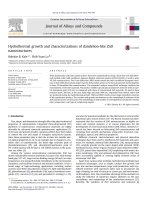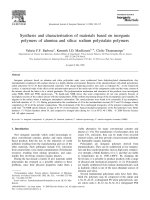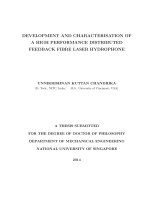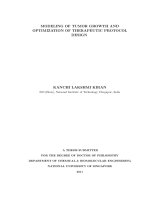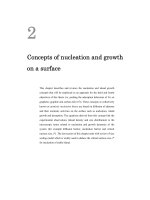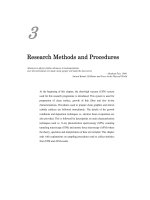Growth and characterisation of cobalt doped zinc oxide 4
Bạn đang xem bản rút gọn của tài liệu. Xem và tải ngay bản đầy đủ của tài liệu tại đây (3.06 MB, 24 trang )
Chapter 4 Structural Characterization
102
CHAPTER 4
STRUCTURAL CHARACTERIZATION AND
CHEMICAL VALENCY ANALYSIS
4.1 Introduction
In this chapter, the structural properties of Co-doped ZnO:Al characterized by
XRD and TEM are discussed. The results of chemical valence analysis using XPS and
optical transmission spectroscopy are also presented. Throughout this thesis, the Co
composition is given as a nominal value which is determined by XPS. As this
technique only has an accuracy of about 5%, caution need to be taken when comparing
the properties of the films obtained in this work with those reported in literature. It is
noted that the Co composition determined in this work tend to be higher than those
reported in literature. This is particularly true when the MR data of samples with
similar nominal Co compositions are being compared.
4.2 XRD patterns
The growth of ZnO films was first optimized without any doping. The optimum
growth conditions for obtaining ZnO films with a good structural quality were found to
be as following: Ar pressure, 5 mTorr, substrate temperature, 500
o
C, and ZnO
sputtering power, 150W. As the non-doped ZnO films were highly resistive, the study
of their transport properties impossible. Thus, all the films prepared were co-doped
with Al through the use of an Al
2
O
3
target. While maintaining a reasonably good
structural quality, the ZnO films were doped using an Al
2
O
3
sputtering power of 30W
and the film has a low resistivity of 1.3 mΩ⋅cm. The Al composition as determined by
XPS was less than 0.1%. For the Al-doped ZnO samples, only ZnO (002) and (004)
Chapter 4 Structural Characterization
103
peaks were detected in the θ−2θ scan of XRD patterns in the range of 30-90
o
. This
indicates that the films prepared were well textured, with the c-axis pointing in the
normal direction of the substrate. The lattice parameter determined for the Al-doped
ZnO film is 3.361Å (a) and 5.488Å (c). This is comparable to pure ZnO films with
values of 3.250Å (a) and 5.207Å (c). As shown in Fig. 4-1 is a typical XRD pattern of
Al-doped ZnO. The FWHM for Al-doped ZnO is about 0.77
o
which is comparable to
the results reported in literature.
1,2
0
1000
2000
3000
4000
5000
6000
30 35 40 45 50
2
θ
θθ
θ
(
o
)
Intensity (counts/s)
Figure 4-1 XRD pattern of an Al-doped ZnO film.
In all samples prepared, ZnO was doped with Al. For the co-doped samples, the
Co composition, x, was controlled by varying the sputtering power of the Co target. In
the specific setup, the minimum controllable power was about 3 W, which gives a Co
composition of about 5 at.% as determined by XPS. As for δ-doped samples, Co was
doped into the Al-doped ZnO films digitally, at a Co sputtering power of 10 W for a
specific duration of time. In general, the co-doped samples have a better structural
ZnO (002)
Al
2
O
3
(006)
Chapter 4 Structural Characterization
104
quality than their δ -doped counterparts, as revealed from the XRD results (not shown
here).
Generally, the crystalline quality of the films degraded as the Co doping
amount was increased. As observed from Fig.4-2, the FWHM of ZnO (002) peak
decreased with an increase in Co concentration initially. It began to increase as the Co
composition exceeded 0.2 and decreased again after reaching a maximum at about 0.3.
The initial decrease of FWHM was somewhat unexpected. It indicated that Co was
soluble in the ZnO host matrix with Co composition of less than 0.2. The decrease of
FWHM indicated that the ZnO:Co film had a better quality than ZnO when both were
grown on the sapphire substrates under the specific conditions used in this study. This
could be attributed to either the difference in thermodynamic properties of ZnO and
ZnO:Co or the slightly smaller diameter of the Co
2+
ions. The upturn at Co
composition of 0.2 was due to the formation of secondary phases, as would be
discussed later and also in following chapters. As the Co sputtering power was further
increased, the film becomes increasingly less textured which results in a peak of
FWHM when the Co content was around 0.3. A further increase of Co composition
beyond this value lead to precipitation of Co nanoparticles, which results in an
improvement of the crystallinity of the ZnO and ZnO:Co phases.
Chapter 4 Structural Characterization
105
0.0
0.5
1.0
1.5
2.0
0.00 0.05 0.10 0.15 0.20 0.25 0.30 0.35
Co composition
FWHM (
o
)
Figure 4-2 ZnO (002) XRD FWHM versus cobalt composition for co-sputter films.
Figs. 4-3 ((a) –(c)) show the XRD patterns of ZnO:Co with different Co
compositions in the scan range of 2 = 30 - 50
o
. The data displayed was divided into
three different ranges of x values, i.e., (a) x < 0.2, (b) 0.2 < x < 0.3 and (c) x 0. 3. For
lightly doped samples, x < 0.2, the XRD spectra showed peaks of ZnO (002) and those
associated with the substrate; no other peaks due to secondary phases were observed.
These results, in combination with the TEM results that would be discussed later,
suggest that the Co was soluble in the ZnO host matrix and no impurity phases were
present at x < 0.2.
Chapter 4 Structural Characterization
106
Figure 4-3
XRD scan of co-doped ZnO films.
As the ionic radius of Co
2+
is about 96% of that of Zn
2+
, the in-plane lattice
constant of relaxed ZnO:Co film was expected to decrease when Zn atoms are replaced
by Co atoms, leading to an increase of out-of-plane lattice constant due its large
Poisson’s ratio. This explained why the (002) peak of ZnO:Co shifts to the lower angle
side of the original (002) peak of ZnO, as shown in Fig. 4-3 (a). This was also an
indication that within this composition range, the Co atoms were soluble in the ZnO
host matrix. The solubility limit of Co in ZnO was found to be about 0.25 in
literature.
3,4
Shown in Fig. 4-4 is the peak position at ~ 34
o
plotted as a function of the
Co composition. It could be seen that up to 0.2 of Co content, there was not much
changes in the peak position, which was expected as the films are composed of single
Chapter 4 Structural Characterization
107
phase co-doped ZnO. As the Co content was further increased towards 0.25, a left shift
in peak position was observed, possibly due to the formation of Co-rich ZnO:Co. A
further increase of Co beyond 0.3 leads to the recovery of the peak to positions near to
those for films with x < 0.2, indicating the onset of phase segregation.
33.4
33.6
33.8
34.0
34.2
34.4
34.6
0 0.05 0.1 0.15 0.2 0.25 0.3 0.35
Co composition
Peak position (
o
)
Figure 4-4 XRD peak position (around 34
o
) versus Co composition.
For samples with x > 0.2, as shown in Fig. 4-3 (b), in addition to the (002) ZnO
peak, new peaks appear at 2 31.8
o
, 35.8-36
o
, 40.6, 42.4 and 44.5
o
, respectively. The
assignment of these peaks was nontrivial because Co might exist in the material in
question in at least five different forms: ZnO:Co, CoO, Co
3
O
4
, ZnCo
2
O
4
and Co. The
peak at around 31.8
o
and
36.253
o
could be assigned to ZnO (100) and (101),
respectively. The CoO nanoparticles might exist in both cubic and hexagonal
structures in the ZnO:Co host matrix. Therefore, the peak around 36
o
may be assigned
to either one of the following peaks due to secondary phases: CoO (111) at 36.493
o
for
cubic CoO, CoO (101) at 36.3
o
for hexagonal CoO, ZnCo
2
O
4
(311) at 36.803
o
and
Co
3
O
4
(311) at 36.853
o
. Also, the peak at 44.5
o
was near peak positions of CoO (200)
Chapter 4 Structural Characterization
108
FCC at 40.6
o
and 42.4
o
, Co (111) at 44.217
o
, ZnCo
2
O
4
(400) at 44.74
o
and Co
3
O
4
(400)
at 44.81
o
.
For 0.2 < x < 0.3, the onset of secondary phase formation occured, with the
secondary phase being presumably hexagonal CoO:Zn or CoO; Other phases like Co,
Co
3
O
4
and ZnCo
2
O
4
may also exist, though they were not dominating based on the
EELS results to be discussed shortly. At this high Co composition, the texture of
ZnO:Co could change, as reflected in the appearance of a broad peak around 31.8
o
. For
sample E (x = 0.24), the peak around 36
o
and 38
o
could be due to CoO (111). The shift
of peak position to lower angles could be a result of Zn incorporation into the CoO
matrix. As the sputtering power was further increased, in sample F (x = 0.25), the CoO
(111) peak disappeared and Co (111) peak appeared. It should be noted that the lattice
constants of hexagonal CoO are very similar to those of ZnO; thus it was difficult to
differentiate between the two using XRD, especially if CoO grew pseudmorphically
inside ZnO. Pole figure measurements (Fig. 4-5) had also been carried out for this
sample and it could be seen from the results that the film was epitaxially grown and
(002) textured. The pole diagram showed that this film was still dominantly single
crystalline, suggesting that the films with Co content less than 0.25 were indeed single
crystalline films with a good texture.
Chapter 4 Structural Characterization
109
Figure 4-5 Pole figure diagram for sample F (Zn
0.75
Co
0.25
O).
As shown in Fig. 4-3 (c), as the Co concentration increased further, peaks at
31.8
o
and 36.1
o
start to disappear, with the appearance of peaks around 44.5
o
. The peak
at 44.5
o
was due to Co clusters, though again the existence of other secondary phases
such as ZnCo
2
O
4
and Co
3
O
4
could not be excluded. The formation of Co clusters was
more probable because the formation of ZnCo
2
O
4
and Co
3
O
4
needed an oxygen-rich
environment instead of more Co atoms.
Before ending this section, there is a need to make the remark that any attempt to
find peaks exactly at the same positions of pure ZnO or CoO is meaningless because
ZnO would incorporate Co and, vice versa, CoO would contain Zn.
4.3 TEM observations
The samples with different Co compositions had been examined by HRTEM.
The samples with Co compositions lower than the solution limit were found to be
homogeneously grown on the substrate. As an example, Fig. 4-6 shows the cross-
sectional TEM image, EDS mapping and diffraction images of the Co15W sample. As
Chapter 4 Structural Characterization
110
can be seen from the TEM image and diffraction pattern, the film was homogeneous
and there were no detectable precipitates of Co.
100 nm100 nm
Figure 4-6
TEM results of co-doped Co15W (Zn
0.80
Co
0.20
O) sample;
(a)
Cross-sectional TEM image;
(b) electron diffraction pattern of the same region; (c)EDS mapping of Al, Co, O and Zn of films, with
direction of film growth as indicated.
In Fig. 4.6 (c), the film’s diffraction pattern showed a single crystalline phase
with no impurity spots. From XRD studies above, peaks had been observed in the
vicinity where CoO (200) is expected. This could be due to the fact that the XRD
pattern was from a large area of sample, whereas the TEM results were from a very
small spot.
Al
Zn
O
Co
Growth direction
50 nm
(a)
(c)
(b)
ZnO :Co
Al
2
O
3
Al
2
O
3
(006)
Chapter 4 Structural Characterization
111
100 nm100 nm
When increasing the Co content to 0.24, it was observed that, similar to the
Co15W sample, the Co20W sample also showed the absence of Co-agglomeration or
precipitation (Fig.4-7(a)). The film, in general, was still homogeneous, though some
external spots were detected in the diffraction pattern, as shown in Fig. 4-7 (b). These
spots could be due to CoO (200), FCC Co (111), HCP Co (002) or even ZnO (101), as
observed in the XRD patterns. The homogeneity of the film was found to degrade
significantly after the Co content exceeds 0.25, the onset composition of secondary
phase formation. As a result, the film quality of Co25W was much poorer as compared
to the above-mentioned two samples. Also, the TEM cross-sectional image (Fig. 4-8
(a)) showed an inhomogeneous film. In Fig. 4-8 (b), the diffraction spots of secondary
phases were seen to increase in quantity.
Fig. 4-9 (a) shows the TEM images of the Co 32W sample, which illustrated
clearly the inhomogeneous nature of the sample. Columnar growth, similar to that
reported by Schaedler et. al.,
5
was observed, together with nanosized secondary
phases, as shown by a dark particle in Fig. 4-9(b). For the corresponding δ-doped
sample, the film structure was found to be very irregular, as shown in Fig. 4-10 (a),
and it could be observed that Co clusters started to form throughout the film. Through
analysis of fast-Fourier transform pattern and also EELS measurements on that
particular particle shows that it exists as FCC Co.
(b)
(a)
Al
2
O
3
ZnO : Co
ZnO
(002)
Extra
spots
Chapter 4 Structural Characterization
112
Figure 4-7
TEM results of co-doped Co20W (Zn
0.76
Co
0.24
O) sample;
(a)
Cross-sectional TEM image;
(b) electron diffraction pattern of the same region; (c)EDS mapping of Al, Co, O and Zn of films, with
direction of film growth as indicated.
Figure 4-8 TEM results of co-doped Co25W (Zn
0.75
Co
0.25
O) sample; (a) Cross-sectional TEM image;
(b) electron diffraction pattern of the same region.
Al
Zn
O
Co
25 nm
Growth direction
Growth direction
100 nm100 nm
(c)
(b)
(a)
ZnO :Co
Al
2
O
3
CoO (111)
CoO (200)
CoO (220)
Chapter 4 Structural Characterization
113
Figure 4-9 TEM results of co-doped Co32W (Zn
0.71
Co
0.29
O) sample;
(a)
Cross-sectional TEM image;
(b) HRTEM image of a selected region; (c) electron diffraction pattern of the same region.
Figure 4-10 TEM results of δ-doped Co98s ([(ZnO:Al (2.38 nm)/Co (1.0 nm)]× 60) sample; (a)
Cross-
sectional TEM image; (b) HRTEM image of a selected region; (c) electron diffraction pattern of the
same region.
(a)
(b) (c)
ZnO:Co
Al
2
O
3
100nm
4nm
ZnO:Co
Al
2
O
3
(a)
(b) (c)
ZnO:Co
Al
2
O
3
100nm
4nm
ZnO:Co
Al
2
O
3
Co
Chapter 4 Structural Characterization
114
The EELS analysis was carried out on co-doped Co32W and δ-doped Co98s
samples. The valence of Co detected from 4 different locations in Fig. 4-9 (a) turned
out all to be 2+ (Fig. 4-11(a)). The results showed that the film consists of mainly Co-
incorporated ZnO and/or Zn-incorporated CoO because the valence state of Co in
ZnCo
2
O
4
and Co
3
O
4
was 3+ and 4+, and that in Co clusters was 0, respectively. In
comparison, the corresponding δ-doped Co98s sample, showed a variation of 0 and 2+
valence state (Fig. 4-11 (b)), at different positions of the sample. These results along
with the electron and x-ray diffraction data confirmed that the δ-doped samples contain
both substitutional Co and Co clusters, whereas the co-doped samples had Co in
valence +2 state, in the form of either Co
2+
ions doped in ZnO or in the form of Co
2+
in
CoO.
Figure 4-11 EELS spectra of L
3
/L
2
of Co for (a) co-doped Co 32W (Zn
0.71
Co
0.29
O) at four different
positions and (b) δ-doped Co 98s samples.
Chapter 4 Structural Characterization
115
Selected area electron diffraction of a particle in the above two heavily Co-
doped samples, as shown in Fig. 4-9 (c) and 4-10 (c), respectively, confirmed the
presence of secondary phases. Detailed study of the diffraction pattern and HRTEM
images showed the presence of hexagonal closed packed (HCP) Co, face center cubic
(FCC) Co, hexagonal CoO and also ZnCo
2
O
4
phase, distributed in the ZnO matrix of
the co-doped sample. This did not contradict the EELS result which suggested that the
sample was dominantly composed of phases containing Co
2+
ions, which could either
be ZnO:Co or CoO:Zn. Before ending this section, it should be stressed again that the
TEM observation could only provide information about the material in a very localized
region; the results don’t necessarily reflect the macroscopic properties of the materials
detected by other techniques.
4.3 XPS, AES and UPS studies
The XPS was used to analyze the chemical environment experienced by Co in
lightly doped samples. Fig.4-12 shows the XPS spectra of samples with different Co
compositions (note that the spectra have not corrected for charge-shift; therefore, the O
1s peak was found at 531 eV). As could be seen from the figure, the Co 2p
3/2
peak
position was at 781.8 eV, while the splits of Co 2p
3/2
and 2p
1/2
were about 15.4 eV for
the samples understudy. As the split for Co metal was about 15.05 eV, one can rule out
the existence of metallic Co clusters in the samples measured. If Co was surrounded by
oxygen, the split would be about 15.5 eV.
3,6
The above results suggested again that
samples with a Co composition less than 0.25 were dominantly ZnO:Co or CoO:Zn,
while those at very high doping levels can possibly contain other secondary phases
such as Co.
Chapter 4 Structural Characterization
116
810 805 800 795 790 785 780 775
Intensity(arb.unit)
Binding Energy(eV)
2P
3/2
2P
1/2
(a)
(b)
(c)
(d)
sat.
sat.
Figure 4-12 XPS spectra measured with photon energy h=900 eV for co-doped samples (a)Co
10W(Zn
0.84
Co
0.16
O), (b) Co 20W (Zn
0.76
Co
0.24
O), (c) Co 25W(Zn
0.75
Co
0.25
O) and (d) Co
30W(Zn
0.73
Co
0.27
O).
From the AES spectra shown in Fig. 4-13, a gradual appearance of a satellite
feature at the high-energy shoulder at about 781 eV was observed as the Co content
increased. This could be due to electron-correlations of some Co ions, possibly
attributed to some trivalent Co ion formation or lattice distortion in the outer surface.
Chapter 4 Structural Characterization
117
2.0
1.5
1.0
0.5
Intensity(arb.unit)
805800795790785780775770
Photon Energy(eV)
a
b
c
d
Figure 4- 13 XAS spectra recorded by LMM AES signal from photoelectrons for samples (a) Co10W
(Zn
0.84
Co
0.16
O), (b) Co 20W (Zn
0.76
Co
0.24
O) , (c) Co 25W(Zn
0.75
Co
0.25
O) and (d) Co30W
(Zn
0.73
Co
0.27
O). Satellite features at the shoulder are marked by a line.
-30 -25 -20 -15 -10 -5 0
Zn 3d
O 2p
Binding energy(eV)
Binding energy(eV)
Intensity(arb.unit)
a
b
c
d
hν=60eV
Figure 4-14 Valence-band UPS spectra, photon energy h=60 eV for samples (a) Co 10W
(Zn
0.84
Co
0.16
O), (b) Co 20W (Zn
0.76
Co
0.24
O), (c) Co 25W (Zn
0.75
Co
0.25
O) and (d) Co30W
(Zn
0.73
Co
0.27
O). The component indicated by an arrow below E
f
about 0.92 eV is developing as Co
content increases.
Chapter 4 Structural Characterization
118
In Fig.4-14, another feature that becomes distinctive as the Co concentration
increased was found at about 0.92 eV below E
f
. It might be attributed to either O 2p or
a minor amount of Co 3d component where a trivalent Co oxide compound was found
to have a feature below E
f
at about 1 eV.
7
The trivalent Co oxide was an indication of
the presence of ZnCo
2
O
4
, as it was also observed from the XRD. Thus, it could be
concluded that the films under this study consist of mainly Co
2+
- containing phases at
x < 0.25 and a mixture of Co
2+
, Co
3+
ions and Co atoms as the Co composition
exceeded 0.25.
4.5 Optical transmission studies
The observation of d-d transitions in the optical transmission spectra is one of
the common “criteria” often used to “prove” that Co atoms have replaced Zn to form
substitutional dopants. The d-d transitions, assigned as
4
A
2
(F) →
2
A
1
(G),
4
A
2
(F) →
4
T
1
(P), and
4
A
2
(F) →
2
E(G) transitions in high spin state Co
2+
(d
7
), were known to have
a wavelength (photon energy) of 571, 618, and 665 nm (2.17, 2.00 and 1.86 eV),
respectively.
8
Fig.4-15 shows the transmittance of samples with different Co
compositions, normalized to their respective value at 800 nm. With the increase of Co
content, the absolute strength of the absorption bands increased almost linearly,
indicating Co atoms substituting Zn to form Co
2+
(d
7
) ions. The amplitude of the
absorption fringes initially increased and then decreased after x reaches 0.25, possibly
due to the fluctuations in local crystal field surrounding different Co ions, in particular
due to the formation of Co-Co bonds and /or Co clusters at very high Co compositions.
Chapter 4 Structural Characterization
119
Figure 4-15 Optical transmission spectra of various samples. ‘*’ marks energy levels used to determine
hysteresis MCD curves in Figure 5-9 for co-doped Co32W, (Zn
0.71
Co
0.29
O).
To show the different absorption bands more clearly, the transmittance (T) with
respect to wavelength () are differentiated, as shown in Fig. 4-16 (dT/d – ). Peaks
observed in this plot corresponded to the maximum rate of change of transmittance
with respect to wavelength. For Al-doped ZnO, without Co doping, a strong peak due
to band edge absorption appears around 345.5 nm. Note that this value is not directly
corresponding to the bandgap; therefore, it should not be compared with the bandgap
of ZnO which is 370 nm.
Similar to the analysis of XRD patterns, here again the samples were divided
into 3 groups to facilitate the discussion. Both a blue-shift (A) and a red-shift (B) of the
band edge absorption for the Co-doped samples when compared to the Al-doped ZnO
were observed. The blue and red shifts varied with the Co composition. Discussion
would begin at the range of x < 0.2, where Co was shown to be soluble in the ZnO host
matrix from the XRD data; the wavelength of peak A decreased, while that of peak B
L
Al-doped ZnO
C
D
E
F
J
H
Chapter 4 Structural Characterization
120
increased. The energy differences between peak A and peak B are 0.41, 0.76, 0.77 and
0.75 eV for samples A, B, C and E, respectively.
Figure 4-16 Differiential transmittance dependence on wavelength (dT/d – )
of various samples,
showing blue-shift peak wavelength (A) and red-shift peak wavelength (B).
Kittilstved et al. observed an absorption band in ZnO:Co (x = 0.035) at an
energy of 0.32 eV below the excitonic transition line of ZnO and assigned it to ligand
valence band to metal charge transfer transitions.
9
Qiu et. al. had observed an
abnormal bandgap narrowing in ZnO:Co nanorods with x = 0 ~ 0.1 and attributed it to
lattice volume expension of ZnO induced by Co-doping. The redshift was found to
follow the relationship
/0.03
0.54(e 1)
x
g
E
−
∆ = −
eV.
10
As shown by the solid-line in Fig.
4-17, the wavelength of peak B followed this relationship below x = 0.23, i.e.,
/0.03
1239/ 3.589 0.54(e 1)
x
B
λ
−
= + −
. On the other hand, the wavelength of peak A
could be fitted well by the equation
1239/(3.589 1.69 )
A
x
λ
= + and the result was
shown by the lower solid curve in the Fig. 4-12. Here, the coefficient of x (1.69 eV)
was taken from the fitting result of excitonic transitions in lightly doped samples
discussed by Pacuski
et. al
11
Chapter 4 Structural Characterization
121
Figure 4-17 Fitting of blue and red shift wavelength to Qiu et. al.
prediction versus Co composition.
[After X. Qiu, 2006, Ref. 10]
By combining the XRD, EELS and optical transmission data, it is argued that
peak A, as shown in Fig. 4-17, was due to Co-rich ZnO:Co phase, while peak B was
due to Zn-rich ZnO:Co phase. Considering the facts that the XRD diffraction peaks are
close to those of ZnO or hexagonal CoO, the wavelength of peak A was close to the
bandgap of CoO
12
(~ 2.9 eV), and the valence of Co was dominantly +2 when x was
below 0.29, the Co-rich ZnO:Co phase was most likely Zn-incorporated CoO. With a
further increase of Co, the Zn-rich phase gradually disappeared; instead the Co-rich
phase and secondary phase clusters become dominant, as shown by the XRD patterns
discussed above.
300
400
500
600
0 20 40
Co composition (at. %)
Wavelength (nm)
Peak A
Peak B
Qiu et al
Qiu et al
Chapter 4 Structural Characterization
122
4.6 Summary
As have discussed in this chapter, ZnO:Co is a very complicated material
system; it is definitely not an easy task to identify all the phases and reveal their
detailed distributions inside the samples with different Co compositions. Nevertheless,
based on the systematic studies carried out using XRD, TEM, XPS, AES, UPS and
optical transmission spectroscopy, the findings can be summarized as following:
(1) Samples with x < 0.2
In this composition range, the Co was soluble in ZnO. At very low doping levels,
the films were dominantly single phase of ZnO doped with Co. However, when x
increased to near 0.2, Co-rich ZnO:Co may form which eventually evolved into
other secondary phases when x increased further.
(2) Samples with 0.2 < x < 0.3
This is the region where onset of secondary phase formation occured. The Co-rich
region of ZnO:Co might start to evolve into Zn-incorporated CoO. Polycrystalline
films with columnar structures started to form, though there was still very low level
of secondary phase precipitation.
(3) Samples with x > 0.3
In this region, the Co began precipitating to form secondary phase nanoclusters.
Secondary phases could be in the form of Co, CoO or ZnCo
2
O
4
.
These results would be further supported by magnetic and electrical properties to be
discussed in the next two chapters.
Chapter 4 Structural Characterization
123
Figure 4-18 Schematic summarizing characteristic of samples prepared.
Co composition (%)
0 15 20
Co composition (%)
25 30 33
Al-doped ZnO
Single phase, (002)
Single phased ZnO doped
with Co
Formation of Co-rich
ZnO:Co
Columnar structure starts
to form
Secondary phase (Co, CoO
or ZnCo
2
O
4
) formation
Co-rich ZnCoO evolves to
form CoO
Co
2+
Co
2+
Co
2+
Co
2+
Co
2+
Co
2+
Co
2+
Co
2+
Co
2+
Co
2
+
Co
2+
Co
2+
CoO
CoO
Co
2+
Co
2+
Co
2+
Co
2+
Co
2+
Co
2+
Co
2+
Co
2+
CoO
CoO
CoO
CoO
ZnCo
2
O
4
Co
2+
CoO
Co
2+
C
oO
Co
Co
2+
Co-rich ZnCoO
Co
ZnCo
2
O
4
Chapter 4 Structural Characterization
124
References:
1
N. Khare, M. J. Kappers, M. Wei, M. G. Blamire, and J. L. MacManus-Driscoll,
“Defect induced ferromagnetism in Co-doped ZnO”, Adv. Mater.
18
, 1449 (2006).
2
A. Dinia, G. Schmerber, V. Pierron-Bohnes, C. Meny, P. Panissod, and E.
Beaurepaire, “Magnetic perpendicular anisotropy in sputtered (Zn
0.75
Co
0.25
)O dilute
magnetic semiconductor”, J. Mag. Mag. Mater.
286
, 37 (2005).
3
H. J. Lee, S. Y. Jeong, C. R. Cho, and C. H. Park, “Study of diluted magnetic
semiconductor: Co-doped ZnO”, Appl. Phys. Lett.
81
, 4020 (2002).
4
Z. Jin, M. Murakami, T. Fukumura, Y. Matsumoto, A. Ohtomo, M. Kawasaki, and H.
Koinuma, “Combinatorial laser MBE synthesis of 3d ion doped epitaxial ZnO thin
films”, J. Cryst. Growth
214/215
, 55 (2000).
5
T. A. Schaedler, A. S. Gandhi, M. Saito, M. Ruhle, R. Gambino, and C. G. Levi,
“Extended solubility of CoO in ZnO and effects on magnetic properties”, J. Mat. Res.
21
, 791 (2006).
6
C. D. Wagner, W. M. Riggs, L. E. Davis, and J. F. Moulder, Handbook of X-ray
Photoelectron Spectroscopy, (Perkin-Elmer Co., 1979), pp. 78.
7
M. Kobayashi, Y. Ishida, J. I. Hwang, T. Mizokawa, A. Fujimori, K. Mamiya, J.
Okamoto, Y. Takeda, T. Okane, Y. Saitoh, Y. Muramatsu, A. Tanaka, H. Saeki, H.
Tabata, and T. Kawai, “Characterization of magnetic components in the diluted
magnetic semiconductor Zn
1–x
Co
x
O by x-ray magnetic circular dichroism”, Phys. Rev.
B
72
, 201201(R) (2005).
8
P. Koidl, “Optical absorption of Co
2+
in ZnO”, Phys. Rev. B
15
, 2493 (1977).
9
K. R. Kittilstved, W. K. Liu, and D. R. Gamelin, “Electronic structure origins of
polarity-dependent high-T
C
ferromagnetism in oxide-diluted magnetic
semiconductors”, Nat. Mater.
5
, 291 (2006).
Chapter 4 Structural Characterization
125
10
X. Qiu, L. Li, and G. Li, “Nature of the abnormal band gap narrowing in highly
crystalline Zn
1–x
Co
x
O nanorods”, Appl. Phys. Lett.
88
, 114103 (2006).
11
W.
Pacuski, D. Ferrand, J. Cibert, C. Deparis, J. A. Gaj, P. Kossacki, and C.
Morhain, “Effect of the s,p-d exchange interaction on the excitons in Zn
1–x
Co
x
O
epilayers”, Phys. Rev. B.
73
, 035214 (2006).
12
G. W. Pratt and R. Coelho, “Optical absorption of CoO and MnO above and below
the Néel temperature”. Phys. Rev.
116
, 281 (1959).
